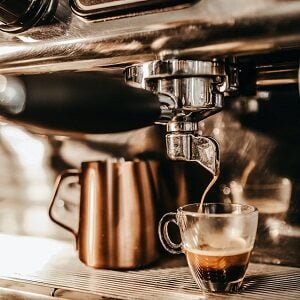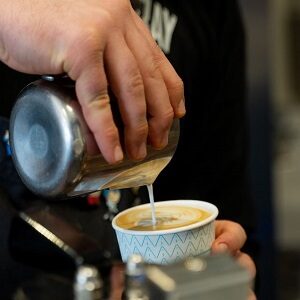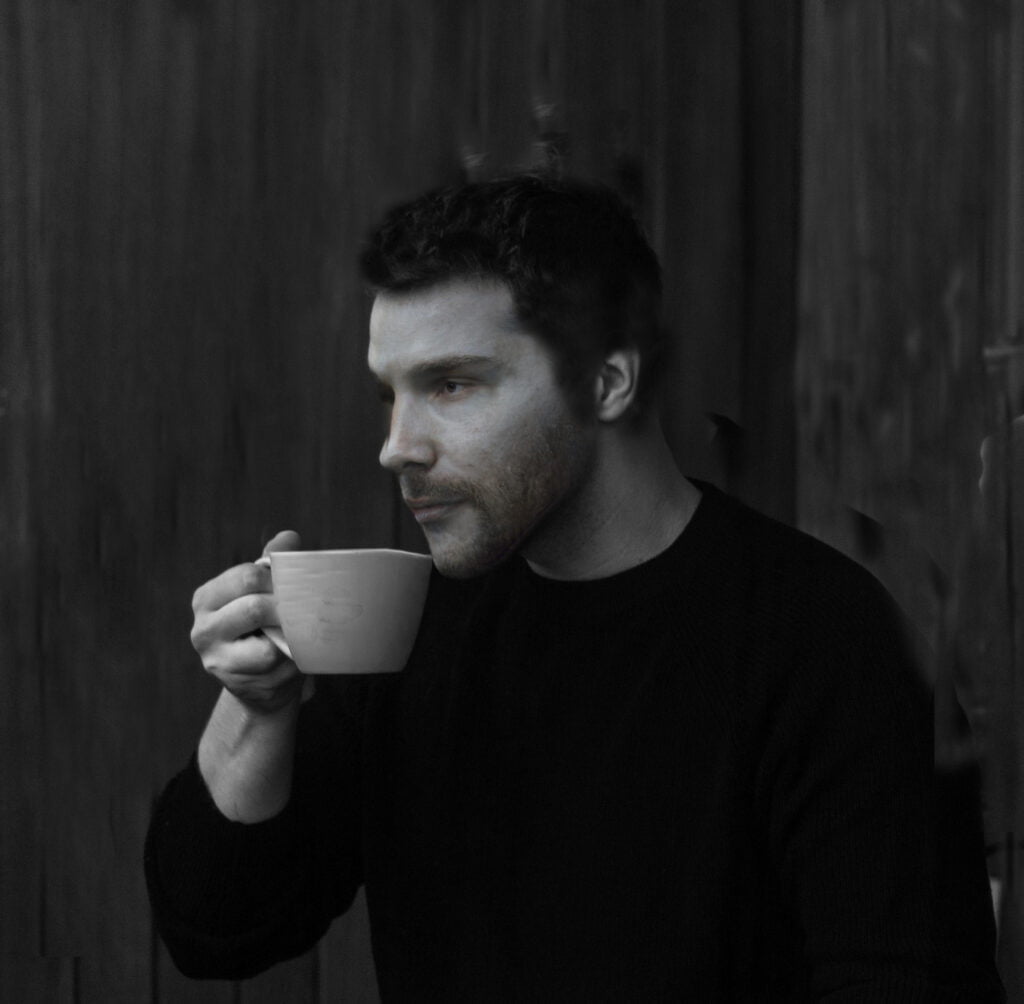A cappuccino is a hot coffee drink that is made of equal proportions of espresso, steamed milk, and milk foam. The drink is typically served in a small cup and is characterized by its rich and creamy texture, as well as its distinct three-layered appearance.
The name cappuccino comes from the Italian word “cappuccio,” which means hood or cap. The drink got its name due to the frothy milk foam that sits on top of the espresso like a cap.
From its early days in Italy to the artisanal cappuccinos of today, few coffee drinks have such an intriguing story. I will cover everything from how to make cappuccino with and without an espresso machine to the different types and benefits of this beloved beverage.

As an Amazon Associate, I earn commission from qualifying purchases.
How to Make a Cappuccino
Here’s a detailed step-by-step guide to making a perfect Cappuccino Recipe at home!
What Do You Need to Prepare Cappuccino
To make a delicious cappuccino at home, you need a few essential tools:
- Espresso Machine – A machine that can make espresso shots.
- Coffee Grinder – To grind fresh coffee beans.
- Milk Frother – To froth the milk.
- Coffee Tamper – To press the coffee grounds.
- Thermometer – To check the temperature of the milk (Not necessary)
- 14-18 grams Coffee Grounds
- 120-150 mL Milk
An espresso machine is the backbone of any specialty coffee setup, and it’s essential for making those rich, intense espresso shot that is the foundation of the Cappuccino.
You also need a coffee grinder to grind fresh coffee beans for the best flavor, and a milk frother to achieve that signature velvety texture.
Moreover, using a thermometer might be optional but is important for beginners to monitor the temperature of milk, which should be between 65-70°C for the perfect froth.
What are The Best Coffee Beans for Cappuccino?
Medium to dark-roasted coffee beans are the best option for rich and strong Cappuccino drinks. The deep, caramelized notes of dark roast coffee complement the creamy milk in a cappuccino, resulting in a perfect balance of flavors for this classic beverage.
I Like Lavazza Espresso Intenso Dark Roast; it’s perfectly rich and strong.
What Milk is best for Cappuccino?
Whole milk is the best choice for preparing the perfect cappuccino as it produces the richest and creamiest froth.
Skim and low-fat milk lack the fat needed to emulsify and not make the ideal foam properly. That said, you can still use 2% reduced-fat milk. It foams decently and provides a compromise on fat and calories.
Soy or oat milk can also work if you are looking for a non-dairy option but may not always froth up the same way as dairy milk.
Step-by-step Instructions:
1. Prepare Espresso: Grind 14-18 grams of fresh coffee beans to a fine consistency and prepare a double shot of espresso in an Espresso machine.
You can also use a Mokapot or French press if you don’t have an Espresso machine. Just make sure to prepare a very strong coffee drink that can stand well against dilution caused by milk.

2. Steam the Milk: Pour 120-150 mL cold milk per serving into the frothing pitcher. Steam and froth the milk until it reaches a temperature of around 150°F and the milk almost doubles in volume.
The steam wand should be inserted just below the surface of the milk and tilted at an angle to create a vortex that helps to incorporate air into the milk and create a microform.

3. Combine Espresso and Milk: Hold the milk pitcher about 3 inches above the cappuccino cup and begin pouring in a circular motion. This motion helps to blend the hot milk and espresso together. As you pour, try to maintain a steady and even stream to prevent any sudden splashing or disruption of the layers.
Hold back the foamier milk with a spoon until you’ve poured the denser steamed milk into the cup. This will allow you to control the ratio of foam to steamed milk and ensure a consistent texture throughout the cappuccino. Once you’ve poured the steamed milk, remove the spoon and pour the lighter foamed milk on top.
This technique allows for a well-balanced cappuccino with a distinct separation between the espresso, steamed milk, and frothed milk layers.

4. Enjoy your Cappuccino: Now enjoy your delicious creation! Take a moment to appreciate the rich aroma and creamy texture of the drink before taking your first sip.

How to Froth Milk for Cappuccino without an Espresso machine?
You can easily create café-quality cappuccino froth at home by heating and frothing milk without using an espresso machine.
French Press: Heat your milk and pour it into a French press, filling it only halfway. Pump the plunger up and down rapidly 20-30 times. The milk will expand and become frothy, creating a creamy texture perfect for cappuccinos.
Whisk: Heat your milk in a saucepan until hot but not boiling. Remove from heat and whisk vigorously using a hand whisk or electric whisk. Continue whisking for 30-60 seconds until the milk becomes frothy and has doubled in volume.
Tips for making good Cappuccino
Here are some of my exclusive tips to raise your cappuccino experience:
- Use freshly roasted coffee beans to ensure a rich and aromatic flavor.
- Use the right amount of espresso shots to balance the flavor and strength of the drink. Traditionally double-shot or triple-shot Espresso is used to prepare Cappuccino, however, if you are in the mood for a smaller drink you can use a single shot. But remember the ratio for a perfect cup of Cappuccino (1 part Espresso, 1 part steamed milk, and 1 part foam).
- Add flavored syrups or toppings like cinnamon or cocoa powder to add a twist to your cappuccino. I like to add a sprinkle of cinnamon or nutmeg on top of my cappuccino for a warm and cozy flavor.
What do Cappuccinos Taste Like?
Cappuccinos have a frothy texture with a strong espresso flavor that is balanced by the sweetness of the milk. You get the bold, slightly bitter notes of the espresso shot complemented by the velvety creaminess of the frothy steamed milk.
A well-made cappuccino has a smooth and balanced taste that is neither too bitter nor too sweet.
I personally love to drink a cup of Cappuccino in the morning to start off my day in a cheerful way!
Types of Cappuccino Drinks
- Iced Cappuccino – This is a cold version of the traditional cappuccino, which is made by pouring the espresso shot over ice and then topping it with cold-frothed milk. It is a very delightful drink and I love it, particularly on hot summer evenings.

- Dry Cappuccino – Also known as a “Scuro,” this type of cappuccino has less steamed milk and more frothed milk, making it drier and lighter in texture. It’s ideal for those who prefer a stronger coffee flavor and a lighter milk texture.

Also Read: Dry vs Wet Cappuccino
- Flavored Cappuccino – It is made by adding flavored syrups, such as vanilla, caramel, chocolate, or hazelnut, to a traditional cappuccino. The flavorings add an extra touch of sweetness to your coffee drink and is a perfect drink for those who like fancy and sweet drinks.
- Cappuccino Misto – This type of cappuccino, also known as a “café au lait,” is made by mixing equal parts of regular brewed coffee and steamed milk. It’s a lighter version of the traditional cappuccino, and it’s perfect for those who prefer a milder coffee flavor. This is a good option for making Cappuccino at home without an Espresso machine.
History and Origins of Cappuccino Coffee
The origin of cappuccino dates back to the 18th century when coffee was first introduced to Italy. However, the modern cappuccino, as we know it today, came onto the scene in the 20th century.
It is believed that the first cappuccino was made in Viennese coffee houses in the 1700s. The drink then spread to Italy, where it was popularized by the Capuchin monks, who wore brown robes similar to the color of the cappuccino drink.
The cappuccino gained popularity in Italy in the mid-20th century after the invention of Modern Espresso machines and soon spread to other parts of the world.
In the United States, the cappuccino became popular in the 1980s and 1990s, as specialty coffee shops and cafes began to grow rapidly across the country.
Today, cappuccino is a popular espresso drink that is enjoyed worldwide.
What’s the Calorie and Caffeine Count in Cappuccino?
A traditional 6-ounce cappuccino made with whole milk and an espresso contains approximately 60 calories. However, if you opt for a larger size or choose non-fat or plant-based milk, the calorie count can go up or down.
Flavored cappuccinos, which typically have added syrups or sweeteners, can significantly increase the calorie count. For instance, a typical vanilla cappuccino can contain up to 200 calories per 8-ounce serving.
Therefore, if you’re watching your calorie intake, it’s important to be mindful of the type of cappuccino you choose.
Cappuccinos have a moderate amount of caffeine, and it depends on the number of Espresso shots in the drink. A single shot of Espresso has 60-72 mg of caffeine while a double shot has 120-133 mg of caffeine.
Cappuccinos can be a part of a healthy and balanced diet when consumed in moderation.
Cappuccino Compared with Other Milk-Based Espresso Drinks
While cappuccino is undoubtedly one of the most popular milk-based espresso drinks, there are other options available that have their unique taste and texture. Some of the popular milk-based espresso drinks include latte, flat white, macchiato, and cortado.
Cappuccino vs Latte
Latte is another popular milk-based espresso drink made with steamed milk and a small amount of frothed milk.
The difference is cappuccino has a higher proportion of frothed milk, which gives it a drier texture and a stronger coffee flavor. The latte, on the other hand, has a higher ratio of steamed milk which gives it a milder coffee flavor and a creamier texture, making it a great choice for those who prefer a sweeter taste.

Read a detailed guide on Latte vs Cappuccino
Cappuccino vs Macchiato
Espresso macchiato is prepared by adding a small amount of frothed milk on top of the Espresso shot.
Macchiatos are served in smaller cups than cappuccinos, and they are not typically topped with any additional ingredients.
A Macchiato has an espresso-forward flavor and isn’t as sweet and creamy as a cappuccino as it is prepared with a very small amount of frother milk.

Cappuccino vs Cortado
Cortado Coffee is made by adding a small amount of steamed milk to a shot of espresso. The steamed milk is added to the espresso in a 1:1 ratio, creating a smooth and velvety drink.
Unlike Cappuccino, a Cortado is prepared only with steamed milk and served in smaller cups without the topping of foamed milk.

Benefits and Drawbacks of Cappuccino
Like most things, cappuccinos have both benefits and drawbacks.
Some of the benefits of cappuccinos include:
- Energy Boost – Cappuccinos are a great source of caffeine, which can help boost your energy levels and help you stay alert and focused throughout the day.
- Social Drink – Many people enjoy cappuccinos as a social drink, either catching up with friends or having a business meeting. Drinking a cappuccino in a cafe or coffee shop can be a great way to relax and socialize.
- May Lower Risk of Certain Diseases: Studies have suggested that regular coffee consumption may help to lower the risk of certain diseases, such as type 2 diabetes, Parkinson’s disease, and liver disease.
- Versatile – Cappuccinos can be customized to suit your personal preferences. You can add different syrups or toppings to create your own unique drink.
Read about 15 amazing health benefits of Espresso
On the other hand, some of the drawbacks of cappuccinos include:
- Calories – Cappuccinos can be high in calories, especially if you add sugar or flavored syrups. Drinking too many cappuccinos can lead to weight gain, which can increase your risk of developing health problems.
- Expense – Drinking cappuccinos on a regular basis can be expensive, especially if you buy them from cafes or coffee shops. Investing in a home espresso machine and learning how to make your own cappuccinos can be a cost-effective solution.
- Caffeine: Cappuccino contains caffeine, which can cause side effects if consumed in excess such as anxiety, jitters, and insomnia in some people. It’s important to moderate caffeine intake and avoid consuming cappuccinos late in the day.
Final Thoughts
All in all, cappuccino is a beloved coffee drink that has captured the hearts of coffee enthusiasts all over the world. From its rich history to the various ways it can be made and enjoyed, there’s no denying that cappuccino is a classic for a reason.
Whether you’re a fan of the traditional cappuccino or prefer a unique twist on the original, there’s a variation out there for everyone to enjoy.
What’s your favorite way to prepare a Cappuccino? Do let us know in the comments!
FAQs
Is a cappuccino stronger than a coffee?
No, a cappuccino isn’t really stronger than regular brewed coffee.
The espresso in a cappuccino has a bold, intense flavor for sure. But once you add the foamed milk, a cappuccino mellows out into a pretty balanced drink. A black cup of drip coffee actually packs stronger coffee flavors.
Can you drink a cappuccino every day?
Yes, you can drink a cappuccino every day. In fact, drinking 1-2 cups of this milky drink has several health benefits.
Nevertheless, if you choose to drink it every day, be sure not to add any sweeteners, syrups, or sugars, as they will add unnecessary calories.
Is cappuccino better in the morning or at night?
Cappuccinos are typically consumed in the morning or early afternoon as a way to start the day or as a midday pick-me-up.
However, there’s no hard and fast rule about when to drink a cappuccino. Just avoid drinking Cappuccino late at night as it can cause trouble in sleeping because of the caffeine.
Cappuccino Recipe
Equipment
- Espresso machine
- Milk Frother
Ingredients
- 14-16 grams Coffee grounds Dark Roasted Coffee beans are preferable
- 120-150 mL Whole Milk Whole 2% Milk is preferred, however you can also use skimmed milk, oat milk or soy milk depending on your preference
- Sugar or Sweeteners (Optional)
- Cocoa Powder (Optional)
Instructions
- Grind 14-16 grams of fresh coffee beans and prepare a double shot of espresso.
- Steam and froth the milk in a milk pitcher using a milk frother until it reaches a temperature of around 150°F.
- Pour the freshly brewed espresso shot into a cappuccino cup. Pour the steamed milk into the cup until it's about 2/3 full while holding back the foam with a spoon. Spoon the milk foam on top to create a thick, velvety layer. If desired, sprinkle some cocoa powder, cinnamon, or chocolate shavings on top of the foam.
- Enjoy your homemade cappuccino while it's hot and fresh!




